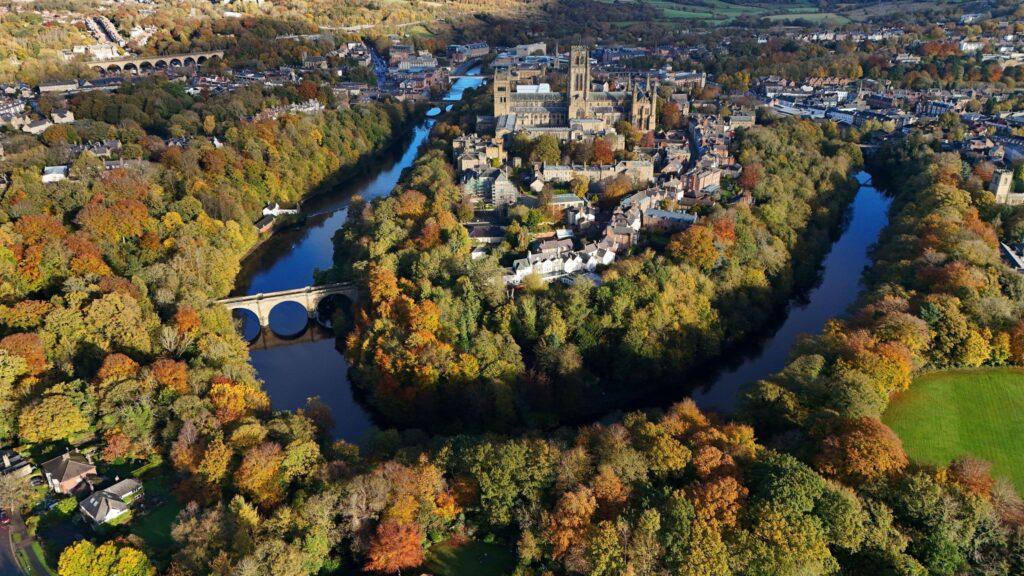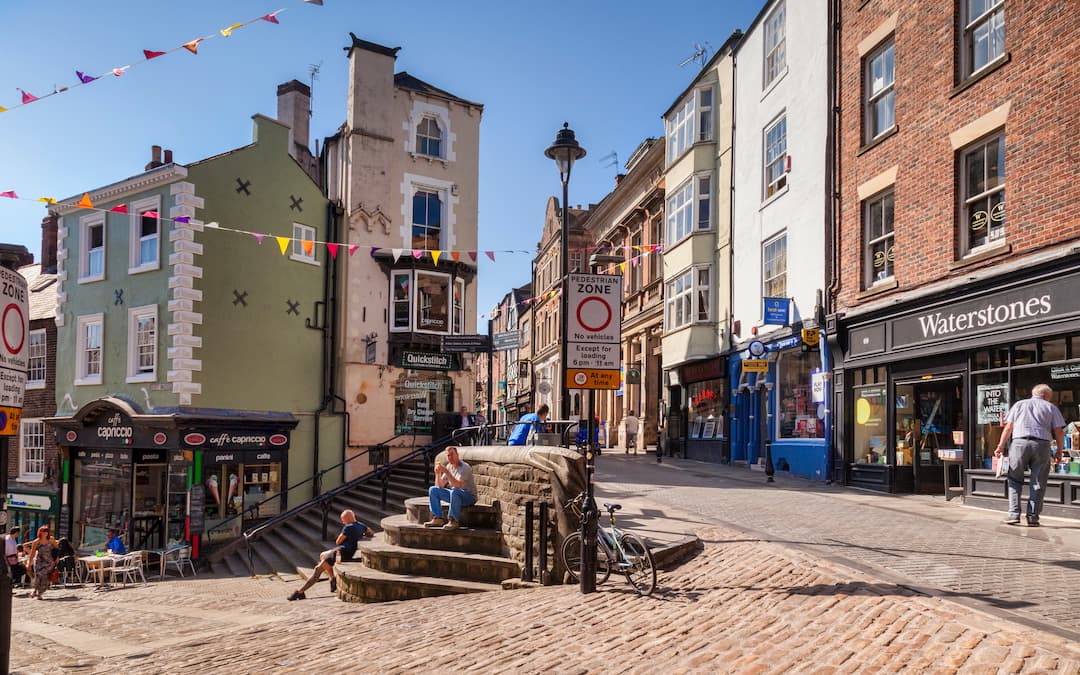Durham, a historic city in the northeast of England, is a place where ancient history and modern life blend seamlessly. Dominated by the world-renowned Durham Cathedral and the formidable Durham Castle, the city rises proudly on a rocky peninsula surrounded by a looping bend of the River Wear. From its deep Christian roots and medieval architecture to its vibrant university culture and scenic countryside, Durham offers a rich tapestry of experiences that captivate residents, students, and visitors alike.

Historical Foundations
Durham’s origins date back over a thousand years. The city grew around the shrine of St Cuthbert, a 7th-century monk and bishop whose relics were brought to the area by Lindisfarne monks in 995 AD. According to legend, the monks had been fleeing Viking raids and were divinely guided to the site where Durham Cathedral now stands. The natural defensive position—on high ground protected on three sides by the River Wear—was ideal for a religious and political stronghold.
The city was formally founded with the construction of Durham Cathedral in 1093, followed shortly after by Durham Castle. Together, they symbolised the authority of the Norman conquerors and the Church. The Prince-Bishops of Durham, appointed by the king, wielded both spiritual and secular power, ruling the region almost as independent princes. This semi-autonomous status continued until 1836 and played a key role in shaping Durham’s identity.
Durham Cathedral and Castle
No description of Durham is complete without mention of its most iconic landmarks. Durham Cathedral, a masterpiece of Norman architecture, stands as one of Europe’s greatest medieval buildings. Designated a UNESCO World Heritage Site in 1986, it is revered not only for its religious significance and architectural innovation—including the earliest known use of ribbed vaulting—but also for its serene atmosphere and historical depth.
The Cathedral houses the shrine of St Cuthbert, as well as the tomb of The Venerable Bede, an 8th-century scholar and historian. Pilgrims and tourists alike are drawn to this sacred space, and many climb the central tower for panoramic views over the city and the surrounding countryside.
Adjacent to the cathedral is Durham Castle, originally built as a defensive stronghold and later converted into a residence for the Prince-Bishops. Today, it forms part of University College, Durham, one of the oldest colleges of Durham University, and students still live within its historic walls. The castle is open to the public through guided tours, offering a unique glimpse into its rich history.
Durham University
Founded in 1832, Durham University is one of the oldest and most prestigious universities in the UK. Often ranked among the top institutions nationally and globally, the university plays a central role in the city’s identity. Its collegiate system, inspired by Oxford and Cambridge, gives the student experience a distinctive community atmosphere.
Students from around the world come to Durham to study a wide range of disciplines, contributing to the city’s cultural diversity and vibrancy. The university hosts numerous events, public lectures, concerts, and exhibitions that are open to the wider community, making it a vital cultural engine for the region.
City Centre and Urban Character
Despite its historic significance, Durham is a compact and walkable city. The city centre is a delightful mix of cobbled streets, independent shops, cafés, markets, and high-street retailers. The Indoor Market Hall, with over 50 independent traders, offers everything from local produce and gifts to crafts and street food. On Saturdays, the Outdoor Market Place is bustling with vendors and locals alike.
Durham’s charm lies in its blend of old and new. You can sip coffee in a 17th-century coaching inn, browse modern boutiques inside repurposed Georgian buildings, or enjoy riverside walks that pass beneath ancient stone bridges.
The Gala Theatre, located near the central market square, offers a wide program of drama, music, film, and comedy. Its modern design contrasts with the historic architecture of the surrounding streets but has become a popular venue for locals and students.
The River Wear and Natural Beauty
One of Durham’s most captivating features is the River Wear, which winds through the city in a tight meander around the cathedral peninsula. Riverside paths, popular with walkers, joggers, and rowers, provide stunning views of the city’s skyline, especially in the early morning or at dusk.
The Durham University Botanic Garden, located on the southern edge of the city, offers 25 acres of woodland, gardens, and exotic plant collections. Nearby, Wharton Park overlooks the city and is an ideal spot for picnics and panoramic photos.
Just beyond the city limits, the Durham Dales and the edges of the North Pennines Area of Outstanding Natural Beauty offer expansive landscapes for hiking, cycling, and outdoor exploration. The area’s rolling hills, stone walls, and rugged moorland make it a paradise for nature lovers.
Festivals and Culture
Durham has a rich calendar of cultural events throughout the year. The Durham Miners’ Gala, held annually in July, is one of the largest trade union gatherings in Europe. It celebrates the region’s coal-mining heritage with brass bands, banners, parades, and speeches on the Palace Green.
Every two years, Durham hosts Lumiere, the UK’s largest light festival. Artists from around the world illuminate the city’s buildings, streets, and riverbanks with extraordinary light installations that transform the city into a dazzling nocturnal spectacle.
Other regular events include the Durham Book Festival, Durham Brass Festival, and St Cuthbert’s Day celebrations. These events reflect both the city’s intellectual life and its deep-rooted traditions.
Industrial Heritage and Modern Transformation
While Durham is often associated with religious and academic institutions, it also played an important role during the Industrial Revolution, particularly in coal mining. The Durham Coalfield was a major employer and economic driver from the 18th century to the mid-20th century. Although most of the pits have now closed, the legacy remains strong, particularly in surrounding towns and villages.
Today, Durham is undergoing a period of thoughtful regeneration. New developments in the Durham Riverside Renewal Project, investments in transport infrastructure, and the development of innovation hubs connected to the university are modernising the city while preserving its historical integrity.
Living in Durham
Durham consistently ranks as one of the best places to live in the UK. Its mix of scenic beauty, strong community spirit, and high-quality education and healthcare make it attractive to families, professionals, and retirees. Property ranges from characterful period homes to new developments, and public transport connects the city efficiently to Newcastle, Sunderland, and the wider northeast.
Durham Railway Station sits on the East Coast Main Line, offering frequent services to London, Edinburgh, and York. The A1(M) motorway and Durham Tees Valley Airport make it accessible to wider regions of the UK and beyond.
Conclusion
Durham is a city that defies easy categorisation. It is at once ancient and modern, sacred and scholarly, peaceful and lively. Its cathedral and castle tell the story of a city born from faith and fortified by power. Its university ensures a youthful, global outlook. Its river and countryside offer natural calm and recreation. And its people—proud, warm, and resilient—continue to shape Durham’s story in the 21st century.
Whether you’re drawn by its history, enchanted by its architecture, invigorated by its landscapes, or inspired by its culture, Durham welcomes you with open arms and leaves a lasting impression. It’s not just a place to visit—it’s a place to experience.

